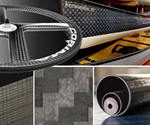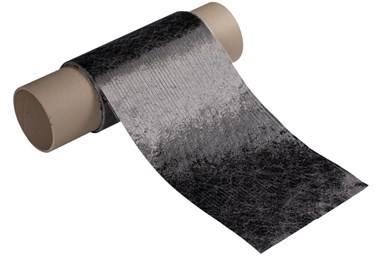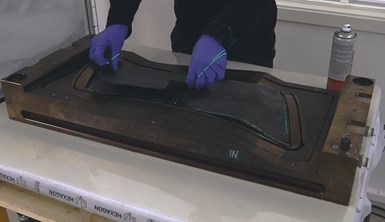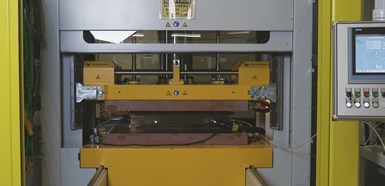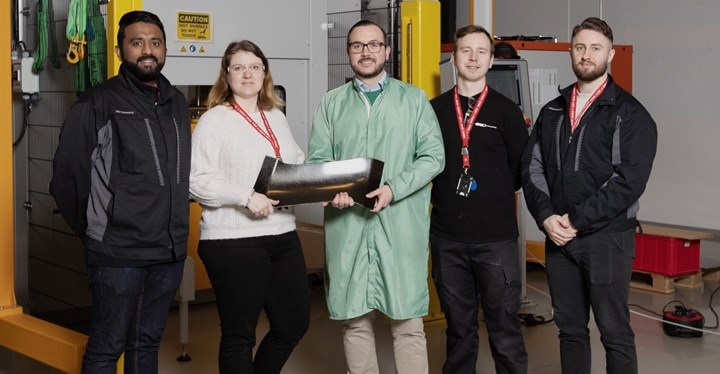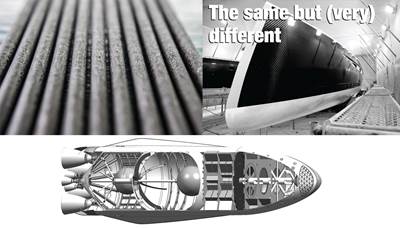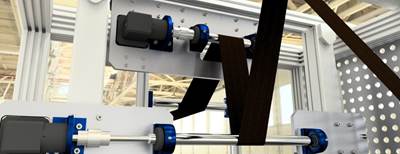Engine vane demonstrates potential for gapped, unidirectional dry fiber for infusion
GKN Aerospace and its partners developed an aircraft demonstrator component made with TeXtreme’s latest Gapped UD material, proving out a dry, infusible tape meant to compare in performance to UD prepreg.
As sectors of the aerospace industry look to adopt composite materials for more programs — and programs with high volume requirements, especially — replacing traditional prepreg layup and autoclave cure with lower cost, faster processing methods like resin infusion is increasingly attractive — that is, if the same quality standards can be achieved.
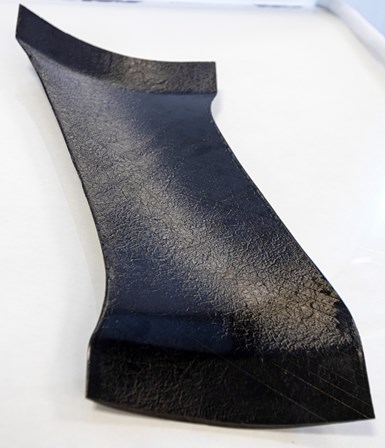
Demonstrating high infusibility with high performance. This aircraft engine guide vane demonstrator, built by GKN Aerospace and partners, was developed to test TeXtreme Gapped UD, a unidirectional (UD) spread-tow carbon fiber product from Oxeon AB that shows potential for UD prepreg-like properties in an infusible fabric. Photo Credit, all images: TeXtreme
In recent years, a number of materials and equipment suppliers have introduced products and solutions that aim to balance high performance with high volume processability such as in automated resin transfer molding (RTM) systems. One relatively new product is a dry, unidirectional (UD), spread-tow tape called TeXtreme Gapped UD, developed by TeXtreme (Boras, Sweden), a registered trademark of spread-tow carbon fiber material developer Oxeon AB.
As debuted at JEC World 2023 in Paris, France, TeXtreme Gapped UD is being used as part of an ongoing demonstrator project with GKN Aerospace (Solihull, U.K.) targeting the aerospace composites market.
Developing TeXtreme Gapped UD
Oxeon first introduced its TeXtreme spread-tow carbon fiber fabrics in 2005. For these materials, UD carbon fiber tows are “spread” into a thinner, flatter form, resulting in a lighter material with straighter fibers and greater impact resistance. These tapes can then be used in automated tape laying (ATL) or automated fiber placement (AFP) processes, or to produce woven fabrics or noncrimp fabrics (NCF).
Andreas Martsman, cofounder and VP of marketing and sales at TeXtreme, explains that TeXtreme Gapped UD was developed in response to requests from customers in the aerospace sector who wanted to replace UD prepreg with infusible materials. “We started by experimenting with infusion of our regular spread-tow tapes, but when you spread out the fibers like this, you also close everything up and there’s a very high fiber volume content,” Martsman says. “This is a bit of a drawback when you’re trying to infuse it with resin.”
Gapped UD tape. TeXtreme claims precise control of gap width and frequency within its UD tape product. The company also offers woven fabrics made with gaps for better resin permeability.
TeXtreme’s team went to the drawing board to develop a dry, spread-tow UD tape specifically suited for infusion, but with the high performance that comes from straight, UD fibers. “The answer was creating gaps in the material for resin to infuse into,” Martsman says, “but that was also a challenge. How big do the gaps need to be? How do you keep them uniform and maintained over different surfaces? So, we had to create an architecture that was robust and stable enough to ensure quality and control during infusion and in service.”
He explains that to do this, TeXtreme uses an in-line vision system during manufacture of the tapes for the highest possible control of gap width and frequency. Typical gaps are 0.3 to 0.4 millimeter in width, but TeXtreme can tailor the width and frequency to enable slower or faster permeability as needed.
After a 5-year development process, the resulting TeXtreme Gapped UD product was officially released at JEC World 2023. It is available in a variety of sizes and fiber weights — and as woven fabrics, if desired — and is said to enable easy handling and resin permeability with fiber volume fractions (FVF) of up to 60%.
Martsman adds that the tapes can be customized to fit a customer’s needs, as they are able to be produced from a wide variety of fibers (various grades of carbon fiber, glass fiber or aramids) and resins (epoxies, various thermosets, even thermoplastic resins). “You can also slice the tapes down to narrower widths, maybe with just one gap in the middle, for example, and then use it for AFP layup,” he says.
Since its launch in spring 2022, Martsman reports that TeXtreme has begun selling material to sporting goods and industrial customers, with a few sports applications made with the material already in production.
Working toward commercial applications in the aerospace market, earlier this year TeXtreme debuted the first results of its ongoing demonstrator program with GKN Aerospace incorporating the Gapped UD composite material.
First aerospace demonstrator: GKN Aerospace engine guide vane
“We have worked with GKN Aerospace for several years on different types of materials and development projects, and when they began looking into new materials for use in RTM [resin transfer molding], we introduced the Gapped UD tape we had been working on,” Martsman says.
Previously, the company had worked with typical infusible materials like dry NCF or dry woven fabrics. However, Fredrik Ohlsson, product development director at TeXtreme, explains that any kind of weft-direction stitching in a dry fabric, even the relatively minimal stitching threads in an NCF fabric, “creates a small kink in the warp direction tow, where it is interrupted by the stitch. In compression, that little deviation from the perfectly straight fiber initiates a point where the structure becomes weaker.” He explains that to account for this weakness, parts made from infused NCF have to be overdesigned, with additional plies and therefore increased thickness and weight to the part. “With our materials, on the other hand, you have absolutely no deviation both in and out of plane, and you can therefore optimize both the material use and weight,” Ohlsson says.
Why not use a UD prepreg? “With a UD prepreg you have the absolute straightness of the filaments and you have the resin there exactly as you want it, but you also have drawbacks with respect to autoclave curing, and logistics such as cold transport and shelf life, which are especially problematic when you’re trying to scale up production,” Ohlsson explains. “So, many companies want to move toward infusion, and we want to aid this process with our material. We’re aiming at prepreg properties with an infusible material. It’s all reflected by the FVF we can reach using our materials. Infusible materials normally have very open structures to allow for infusion of the resin and air evacuation, but this means a relatively low FVF. With our material, we have very precise, designated flow channels for introduction of the resin and to evacuate air for that low void content, but the material is tight enough to also reach an FVF up to 60% for the higher mechanical properties possible with more fiber.”
In collaboration with testing and demo specialist Produktionstekniskt Centrum (PTC, Trollhättan, Sweden) and with financial support from Tillväxtverket (The Swedish Agency for Economic and Regional Growth) and regional council Västra Götalandsregionen, GKN Aerospace and TeXtreme began a demonstrator project at GKN’s Trollhättan, Sweden facility.
An engine guide vane — a curved panel for directing gas, water or air within a turbine — was selected as the demonstrator component, based on a typical customer design from GKN. “It has a complex geometry with double curvatures, and is fairly thick compared to, say, your typical single-ply, flat test panel, which is good for demonstrating infusibility of the material over differing thicknesses and over curves,” Ohlsson explains. “The load case is also very complex, so performance, especially in compression, is critical for a part like this.”
The part was designed as a multi-ply, rectangular structure with varying thickness along the part, up to 10 millimeters thick in the center section. For this project, an intermediate modulus carbon fiber and Hexcel (Stamford, Conn., U.S.) RTM6 epoxy were used. “We wanted to start with materials most similar to what GKN had been using previously, to give an apples-to-apples comparison,” Ohlsson says.
Guided layup. For the GKN guide vane demonstrator, multiple plies of TeXtreme Gapped UD were laid up at varying orientations for the desired thickness and curvature.
To manufacture the demonstrator part, the plies were cut via a Zünd (Altstätten, Switzerland) automated cutting system. The goal was to simulate use of the material in a high-volume, automation-driven production process, explains Guillaume Moreau, project manager for product development at TeXtreme, and to show that the material handles well with GKN’s automated equipment. “Unlike a typical dry fabric, there is no fraying at the edges when it’s cut,” he adds.
Guided by a laser projector, technicians then laid up the plies onto a mold and debulked under a vacuum bag to create the preform. The preform was then transferred to a closed mold, and loaded into a Langzauner (Lambrechton, Austria) compression press, where resin was injected under heat and pressure to complete the RTM process.
The first demonstrator parts were completed in late 2022 and displayed in April 2023 at JEC World. Ohlsson explains that after this initial success, the teams are continuing to work on adjusting process parameters and material characteristics for an optimized final product. Next, the teams also plan to evaluate additional materials, such as alternative fiber configurations and tougher epoxies, with the same part, aiming for mechanical testing to compare the properties of various Gapped UD guide vanes with each other and with traditional NCF composite versions.
Ultimately, the goal is to optimize the materials and process for adoption by GKN Aerospace for use on a production part, and for TeXtreme, the learnings gained from this first program will help guide its development of Gapped UD materials for other customers and end markets. “There’s a lot of work to do, but there’s a lot of potential for a UD infused fabric, both in aerospace and in markets like marine, wind and more,” Ohlsson says.
Related Content
Infinite Composites: Type V tanks for space, hydrogen, automotive and more
After a decade of proving its linerless, weight-saving composite tanks with NASA and more than 30 aerospace companies, this CryoSphere pioneer is scaling for growth in commercial space and sustainable transportation on Earth.
Read MoreMcLaren celebrates 10 years of the McLaren P1 hybrid hypercar
Lightweight carbon fiber construction, Formula 1-inspired aerodynamics and high-performance hybrid powertrain technologies hallmark this hybrid vehicle, serve as a springboard for new race cars.
Read MoreThe lessons behind OceanGate
Carbon fiber composites faced much criticism in the wake of the OceanGate submersible accident. CW’s publisher Jeff Sloan explains that it’s not that simple.
Read MorePlant tour: Albany Engineered Composites, Rochester, N.H., U.S.
Efficient, high-quality, well-controlled composites manufacturing at volume is the mantra for this 3D weaving specialist.
Read MoreRead Next
The spread of spread tow
Advancing from “lighter and thinner” to boosting strength, stiffness, impact resistance and productivity, spread tow unlocks new applications and markets.
Read MoreSpread tow brings new life to legacy markets
Spread tow and thin ply open new opportunities in composites for golf shafts/driveshafts, boats and spacecraft thanks to improvements in lead time, weight and performance.
Read MoreHow is tow spread?
ITA characterizes tow spreading processes and parameters as it develops new technology to speed production (100 m/min) and reduce width variation (<1mm).
Read More
.jpg;width=70;height=70;mode=crop)
